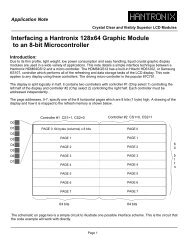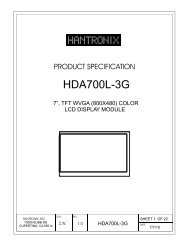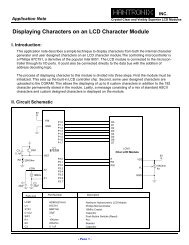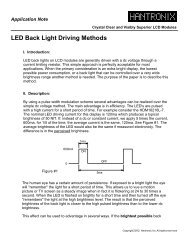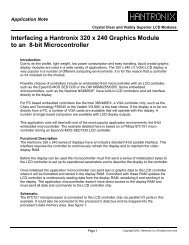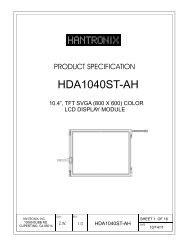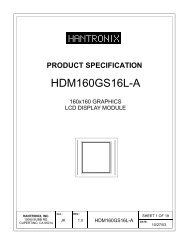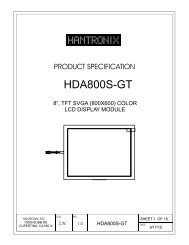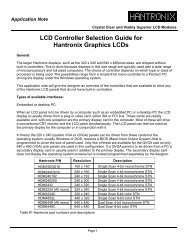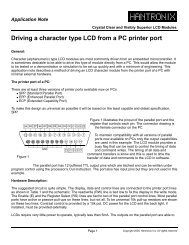Holtek HT1622 - Hantronix, Inc
Holtek HT1622 - Hantronix, Inc
Holtek HT1622 - Hantronix, Inc
Create successful ePaper yourself
Turn your PDF publications into a flip-book with our unique Google optimized e-Paper software.
<strong>HT1622</strong><br />
RAM Mapping 328 LCD Controller for I/O C<br />
Features<br />
Operating voltage: 2.7V~5.2V<br />
Built-in RC oscillator<br />
1/4 bias, 1/8 duty, frame frequency is 64Hz<br />
Max. 328 patterns, 8 commons, 32 segments<br />
Built-in internal resistor type bias generator<br />
3-wire serial interface<br />
8 kinds of time base/WDT selection<br />
Time base or WDT overflow output<br />
Built-in LCD display RAM<br />
R/W address auto increment<br />
<br />
<br />
<br />
<br />
<br />
<br />
<br />
Two selectable buzzer frequencies<br />
(2kHz/4kHz)<br />
Power down command reduces power<br />
consumption<br />
Software configuration feature<br />
Data mode and Command mode instructions<br />
Three data accessing modes<br />
VLCD pin to adjust LCD operating voltage<br />
Cascade application<br />
General Description<br />
<strong>HT1622</strong> is a peripheral device specially designed<br />
for I/O type C used to expand the display<br />
capability. The max. display segment of<br />
the device are 256 patterns (328). It also supports<br />
serial interface, buzzer sound, Watchdog<br />
Timer or time base timer functions. The<br />
<strong>HT1622</strong> is a memory mapping and multi-function<br />
LCD controller. The software configuration<br />
feature of the <strong>HT1622</strong> make it suitable for multiple<br />
LCD applications including LCD modules<br />
and display subsystems. Only three lines are<br />
required for the interface between the host controller<br />
and the <strong>HT1622</strong>. The HT162X series<br />
have many kinds of products that match various<br />
applications.<br />
Selection Table<br />
HT162X HT1620 HT1621 <strong>HT1622</strong> <strong>HT1622</strong>0 HT1623 HT1625 HT1626<br />
COM 4 4 8 8 8 8 16<br />
SEG 32 32 32 32 48 64 48<br />
Built-in Osc. <br />
Crystal Osc. <br />
1 January 10, 2001
#<br />
&<br />
%<br />
$<br />
#<br />
"<br />
!<br />
<strong>HT1622</strong><br />
Block Diagram<br />
, EIF=O4 ) <br />
5 + 1<br />
+ 5<br />
4 ,<br />
9 4<br />
, ) 6 )<br />
+ J H <br />
= @<br />
6 E E C<br />
+ EH K EJ<br />
+ , , H EL A H <br />
* E= I + EH K EJ<br />
+ <br />
+ %<br />
5 - / <br />
8 , ,<br />
8 5 5<br />
* <br />
* <br />
5 - / ! <br />
8 + ,<br />
6 A . H A G K A O9 = J D @ C 6 E A H<br />
/ A A H = J H<br />
= @<br />
14 3<br />
6 E A * = I A / A A H = J H<br />
Pin Assignment<br />
+<br />
5 - / <br />
5 - / <br />
5 - /<br />
5 - / !<br />
5 - / "<br />
5 - / #<br />
5 - / $<br />
5 - / %<br />
5 - / &<br />
5 - / '<br />
5 - / ! <br />
5 - / ! <br />
+ 5<br />
+<br />
4 ,<br />
9 4<br />
, ) 6 )<br />
8 5 5<br />
5 + 1<br />
8 , ,<br />
8 + ,<br />
14 3<br />
* <br />
+<br />
* <br />
6 <br />
6<br />
6 !<br />
+ <br />
+ <br />
+<br />
$ <br />
$<br />
$ !<br />
$ "<br />
<br />
!<br />
"<br />
#<br />
$<br />
%<br />
&<br />
'<br />
<br />
<br />
<br />
!<br />
"<br />
#<br />
$<br />
%<br />
&<br />
'<br />
<br />
<br />
$ <br />
# &<br />
# '<br />
# %<br />
# #<br />
# $<br />
0 6 $<br />
$ " 3 . 2<br />
! <br />
'<br />
# !<br />
# "<br />
# <br />
# <br />
" '<br />
" &<br />
" %<br />
" $<br />
" #<br />
" "<br />
" !<br />
"<br />
" <br />
" <br />
! '<br />
! &<br />
! %<br />
! $<br />
! #<br />
! "<br />
! !<br />
!<br />
! <br />
+<br />
+<br />
+<br />
5 - / '<br />
5 - / &<br />
5 - / %<br />
5 - / $<br />
5 - / #<br />
5 - / "<br />
5 - / !<br />
5 - / <br />
5 - / <br />
5 - / <br />
5 - / '<br />
5 - / &<br />
5 - / %<br />
+<br />
+<br />
+<br />
5 - / $<br />
5 - / #<br />
5 - / "<br />
5 - / !<br />
5 - /<br />
5 - / <br />
5 - / <br />
+ %<br />
+ $<br />
+ #<br />
+ "<br />
+ !<br />
+ <br />
2 January 10, 2001
<strong>HT1622</strong><br />
Pad Assignment<br />
5 - / <br />
5 - / <br />
5 - /<br />
5 - / !<br />
5 - / "<br />
5 - / #<br />
5 - / $<br />
5 - / %<br />
5 - / &<br />
5 - / '<br />
5 - / ! <br />
5 - / ! <br />
+ 5<br />
4 ,<br />
9 4<br />
, ) 6 )<br />
8 5 5<br />
5 + 1<br />
8 , ,<br />
8 + ,<br />
14 3<br />
* <br />
<br />
!<br />
"<br />
#<br />
$<br />
%<br />
&<br />
'<br />
<br />
# "<br />
# !<br />
#<br />
# # <br />
" '<br />
" &<br />
" %<br />
" $<br />
" # " " " !<br />
<br />
"<br />
" <br />
" <br />
! '<br />
! &<br />
! %<br />
! $<br />
! #<br />
! "<br />
! !<br />
!<br />
! <br />
! <br />
5 - / '<br />
5 - / &<br />
5 - / %<br />
5 - / $<br />
5 - / #<br />
5 - / "<br />
5 - / !<br />
5 - / <br />
5 - / <br />
5 - / <br />
5 - / '<br />
5 - / &<br />
5 - / %<br />
* <br />
<br />
6 <br />
6<br />
6 !<br />
+ <br />
+ <br />
<br />
!<br />
"<br />
#<br />
$<br />
%<br />
&<br />
'<br />
<br />
<br />
!<br />
"<br />
#<br />
$<br />
%<br />
& '<br />
5 - / $<br />
5 - / #<br />
5 - / "<br />
5 - / !<br />
5 - /<br />
5 - / <br />
5 - / <br />
+ %<br />
+ $<br />
+ #<br />
+ "<br />
+ !<br />
+ <br />
Chip size: 149 155 (mil) 2<br />
* The IC substrate should be connected to VDD in the PCB layout artwork.<br />
3 January 10, 2001
<strong>HT1622</strong><br />
Pad Coordinates<br />
Unit: mil<br />
Pad No. X Y Pad No. X Y<br />
1 68.43 71.78 28 48.15 71.91<br />
2 68.43 59.46 29 54.78 71.91<br />
3 68.43 52.83 30 69.32 10.67<br />
4 69.19 39.14 31 69.32 4.04<br />
5 69.36 23.89 32 69.32 2.59<br />
6 69.36 16.32 33 69.32 9.22<br />
7 69.36 9.69 34 69.32 15.85<br />
8 69.36 3.06 35 69.32 22.48<br />
9 69.36 3.57 36 69.32 29.11<br />
10 69.36 16.92 37 69.32 35.74<br />
11 69.36 33.83 38 69.32 42.37<br />
12 69.36 43.52 39 69.32 49.00<br />
13 69.36 50.15 40 69.32 55.63<br />
14 69.36 56.78 41 69.32 62.26<br />
15 69.36 63.41 42 69.32 68.89<br />
16 69.36 70.04 43 14.19 71.78<br />
17 39.23 71.14 44 7.57 71.78<br />
18 32.60 71.14 45 0.94 71.78<br />
19 20.19 71.14 46 5.70 71.78<br />
20 13.56 71.14 47 12.32 71.78<br />
21 1.15 71.14 48 18.95 71.78<br />
22 5.48 71.14 49 25.58 71.78<br />
23 15.00 71.91 50 32.22 71.78<br />
24 21.63 71.91 51 38.85 71.78<br />
25 28.26 71.91 52 45.47 71.78<br />
26 34.89 71.91 53 52.10 71.78<br />
27 41.52 71.91 54 58.74 71.78<br />
4 January 10, 2001
<strong>HT1622</strong><br />
Pad Description<br />
Pad No. Pad Name I/O Description<br />
1 CS I<br />
2 RD I<br />
Chip selection input with Pull-high resistor. When the CS is logic<br />
high, the data and command read from or written to the <strong>HT1622</strong><br />
are disabled. The serial interface circuit is also reset. But if CS is<br />
at logic low level and is input to the CS pad, the data and command<br />
transmission between the host controller and the <strong>HT1622</strong><br />
are all enabled.<br />
READ clock input with Pull-high resistor. Data in the RAM of<br />
the <strong>HT1622</strong> are clocked out on the rising edge of the RD signal.<br />
The clocked out data will appear on the data line. The host controller<br />
can use the next falling edge to latch the clocked out data.<br />
3 WR I<br />
WRITE clock input with Pull-high resistor. Data on the DATA<br />
line are latched into the <strong>HT1622</strong> on the rising edge of the WR signal.<br />
4 DATA I/O Serial data input/output with Pull-high resistor<br />
5 VSS Negative power supply, ground<br />
6 OSCI I<br />
If the system clock comes from an external clock source, the external<br />
clock source should be connected to the OSCI pad.<br />
7 VDD Positive power supply<br />
8 VLCD I LCD operating voltage input pad<br />
9 IRQ O<br />
Time base or Watchdog Timer overflow flag, NMOS open drain<br />
output<br />
10, 11 BZ, BZ O 2kHz or 4kHz tone frequency output pair<br />
12~14 T1~T3 I Not connected<br />
15~22 COM0~COM7 O LCD common outputs<br />
23~54 SEG0~SEG31 O LCD segment outputs<br />
Absolute Maximum Ratings<br />
Supply Voltage..............................0.3V to 5.5V<br />
Input Voltage................V SS 0.3V to V DD +0.3V<br />
Storage Temperature.................50C to125C<br />
Operating Temperature ..............25C to75C<br />
Note: These are stress ratings only. Stresses exceeding the range specified under Absolute Maximum<br />
Ratings may cause substantial damage to the device. Functional operation of this device<br />
at other conditions beyond those listed in the specification is not implied and prolonged exposure<br />
to extreme conditions may affect device reliability.<br />
5 January 10, 2001
<strong>HT1622</strong><br />
D.C. Characteristics<br />
Ta=25C<br />
Symbol Parameter<br />
V DD<br />
Test Conditions<br />
Min. Typ. Max. Unit<br />
Conditions<br />
V DD Operating Voltage 2.7 5.2 V<br />
I DD1<br />
I DD2<br />
I STB<br />
V IL<br />
V IH<br />
I OL1<br />
I OH1<br />
I OL1<br />
I OH1<br />
I OL2<br />
I OH2<br />
I OL3<br />
I OH3<br />
R PH<br />
Operating Current<br />
Operating Current<br />
Standby Current<br />
Input Low Voltage<br />
Input High Voltage<br />
BZ, BZ, IRQ<br />
BZ, BZ<br />
DATA<br />
DATA<br />
LCD Common Sink Current<br />
LCD Common Source Current<br />
LCD Segment Sink Current<br />
LCD Segment Source Current<br />
Pull-high Resistor<br />
3V No load/LCD ON 80 210 A<br />
5V On-chip RC oscillator 135 415 A<br />
3V No load/LCD OFF 8 30 A<br />
5V On-chip RC oscillator 20 55 A<br />
3V No load<br />
1 8 A<br />
5V Power down mode 2 16 A<br />
3V<br />
DATA, WR, CS,RD<br />
0 0.6 V<br />
5V 0 1.0 V<br />
3V<br />
DATA, WR, CS,RD<br />
2.4 3 V<br />
5V 4.0 5 V<br />
3V V OL =0.3V 0.9 1.8 mA<br />
5V V OL =0.5V 1.7 3 mA<br />
3V V OH =2.7V 0.9 1.8 mA<br />
5V V OH =4.5V 1.7 3 mA<br />
3V V OL =0.3V 200 450 A<br />
5V V OL =0.5V 250 500 A<br />
3V V OH =2.7V 200 450 A<br />
5V V OH =4.5V 250 500 A<br />
3V V OL =0.3V 15 40 A<br />
5V V OL =0.5V 100 200 A<br />
3V V OH =2.7V 15 30 A<br />
5V V OH =4.5V 45 90 A<br />
3V V OL =0.3V 15 30 A<br />
5V V OL =0.5V 70 150 A<br />
3V V OH =2.7V 6 13 A<br />
5V V OH =4.5V 20 40 A<br />
3V<br />
DATA, WR, CS,RD<br />
100 200 300 k<br />
5V 50 100 150 k<br />
6 January 10, 2001
<strong>HT1622</strong><br />
A.C. Characteristics<br />
Ta=25C<br />
Symbol Parameter<br />
V DD<br />
Test Conditions<br />
Conditions<br />
Min. Typ. Max. Unit<br />
f SYS1 System Clock 3V On-chip RC oscillator 22 32 40 kHz<br />
5V 24 32 40 kHz<br />
f SYS2<br />
f LCD1<br />
System Clock<br />
LCD Frame Frequency<br />
3V<br />
External clock source<br />
32 kHz<br />
5V 32 kHz<br />
3V<br />
On-chip RC oscillator<br />
44 64 80 Hz<br />
5V 48 64 80 Hz<br />
3V 64 <br />
f LCD2 LCD Frame Frequency<br />
External clock source<br />
5V 64 <br />
t COM LCD Common Period n: Number of COM n/f LCD sec<br />
f CLK1<br />
f CLK2<br />
t CS<br />
Serial Data Clock (WR pin)<br />
Serial Data Clock (RD pin)<br />
Serial Interface Reset Pulse<br />
Width (Figure 3)<br />
3V<br />
Duty cycle 50%<br />
150 kHz<br />
5V 300 kHz<br />
3V<br />
Duty cycle 50%<br />
75 kHz<br />
5V 150 kHz<br />
CS 250 ns<br />
t CLK<br />
t r ,t f<br />
t su<br />
t h<br />
t su1<br />
t h1<br />
WR, RDInput Pulse Width<br />
(Figure 1)<br />
Rise/Fall Time Serial Data<br />
Clock Width (Figure 1)<br />
Setup Time for DATA to WR,<br />
RD Clock Width (Figure 2)<br />
Hold Time for DATA to WR,<br />
RD, Clock Width (Figure 2)<br />
Setup Time for CS to WR, RD<br />
Clock Width (Figure 3)<br />
Hold Time for CS to WR, RD<br />
Clock Width (Figure 3)<br />
3V Write mode 3.34 s<br />
Read mode 6.67 <br />
5V Write mode 1.67 s<br />
Read mode 3.34 <br />
3V<br />
5V<br />
3V<br />
5V<br />
3V<br />
5V<br />
3V<br />
5V<br />
3V<br />
5V<br />
120 ns<br />
120 ns<br />
120 ns<br />
100 ns<br />
100 ns<br />
7 January 10, 2001
<strong>HT1622</strong><br />
8 ) 1 , , ) 6 )<br />
9 4 4 ,<br />
+ <br />
J B<br />
8<br />
' <br />
, ,<br />
# <br />
/ ,<br />
J + J + <br />
Figure 1<br />
J H<br />
, *<br />
9 4 4 ,<br />
+ <br />
# <br />
# <br />
/ ,<br />
J I K J D<br />
8 , ,<br />
Figure 2<br />
8 , ,<br />
/ ,<br />
+ 5<br />
J + 5<br />
8 , ,<br />
# <br />
/ ,<br />
J IK<br />
J D <br />
9 4 4 ,<br />
+ <br />
# <br />
. 1 4 5 6<br />
+ <br />
) 5 6<br />
+ <br />
8 , ,<br />
/ ,<br />
Figure 3<br />
Functional Description<br />
Display memory RAM structure<br />
The static display RAM is organized into 644<br />
bits and stores the display data. The contents of<br />
the RAM are directly mapped to the contents of<br />
the LCD driver. Data in the RAM can be accessed<br />
by the READ, WRITE and<br />
READ-MODIFY-WRITE commands. The following<br />
is a mapping from the RAM to the LCD<br />
patterns.<br />
+ %<br />
+ $<br />
+ #<br />
+ "<br />
+ !<br />
Time base and Watchdog Timer (WDT)<br />
The time base generator and WDT share the<br />
same divided (/256) counter. TIMER<br />
DIS/EN/CLR, WDT DIS/EN/CLR and IRQ<br />
EN/DIS are independent from each other. Once<br />
the WDT time-out occurs, the IRQ pin will remain<br />
at logic low level until the CLR WDT or<br />
the IRQ DIS command is issued.<br />
+ <br />
+ <br />
+ <br />
5 - / <br />
<br />
<br />
5 - / <br />
!<br />
5 - /<br />
#<br />
"<br />
5 - / !<br />
%<br />
$<br />
) @ @ H A I I $ * EJ I<br />
) # ) " ) <br />
5 - / ! <br />
$ !<br />
) @ @ H<br />
, ! , , , , = J =<br />
) @ @ H<br />
, ! , , , , = J =<br />
$<br />
, = J = " * EJ I<br />
, ! , , , <br />
RAM mapping<br />
8 January 10, 2001
<strong>HT1622</strong><br />
+ 5 KHA<br />
6 E A * = I A<br />
# $<br />
8 , ,<br />
6 1 - 4 - , 1 5<br />
9 , 6 - , 15<br />
14 3<br />
+ 4 6 E A H<br />
9 , 6<br />
"<br />
,<br />
+ <br />
4<br />
3<br />
14 3 - , 15<br />
+ 4 9 , 6<br />
Timer and WDT configurations<br />
If an external clock is selected as the source of<br />
system frequency, the SYS DIS command turns<br />
out invalid and the power down mode fails to be<br />
carried out until the external clock source is removed.<br />
Buzzer tone output<br />
A simple tone generator is implemented in the<br />
<strong>HT1622</strong>. The tone generator can output a pair<br />
of differential driving signals on the BZ and BZ<br />
which are used to generate a single tone.<br />
Command format<br />
The <strong>HT1622</strong> can be configured by the software<br />
setting. There are two mode commands to configure<br />
the <strong>HT1622</strong> resource and to transfer the<br />
LCD display data.<br />
The following are the data mode ID and the<br />
command mode ID:<br />
Operation Mode ID<br />
READ Data 1 1 0<br />
WRITE Data 1 0 1<br />
READ-MODIFY-WRITE Data 1 0 1<br />
COMMAND Command 1 0 0<br />
If successive commands have been issued, the<br />
command mode ID can be omitted. While the<br />
system is operating in a non-successive command<br />
or a non-successive address data mode,<br />
the CS pin should be set to "1" and the previous<br />
operation mode will be reset also. The CS pin<br />
returns to "0", a new operation mode ID should<br />
be issued first.<br />
Name Command Code Function<br />
TONE OFF 0000-1000-X Turn-off tone output<br />
TONE 4K 010X-XXXX-X Turn-on tone output, tone frequency is 4kHz<br />
TONE 2K 0110-XXXX-X Turn-on tone output, tone frequency is 2kHz<br />
9 January 10, 2001
<strong>HT1622</strong><br />
Timing Diagrams<br />
READ mode (command code :110)<br />
+ 5<br />
9 4<br />
4 ,<br />
, ) 6 )<br />
) #) " ) ! ) ) ) , , , , ! ) #) " ) ! ) ) ) , , , , !<br />
A H O ) @ @ H A I I , = J = ) ) A H O ) @ @ H A I I ,) = J = ) <br />
READ mode (successive address reading)<br />
+ 5<br />
9 4<br />
4 ,<br />
, ) 6 )<br />
) #) " ) ! ) ) ) , , , , ! , , , , ! , , , , ! , , , , ! , <br />
A HO ) @ @ HA I I ) , = , J= = J= ) ) , = J= ) , = J= ) ! <br />
10 January 10, 2001
<strong>HT1622</strong><br />
WRITE mode (command code :101)<br />
+ 5<br />
9 4<br />
, ) 6 )<br />
) #) " ) ! ) ) ) , , , , ! ) #) " ) ! ) ) ) , , , , !<br />
A H O ) @ @ H A I I ) , = J = ) A<br />
H O ) @ @ H A I I ) , = J = ) <br />
WRITE mode (successive address writing)<br />
+ 5<br />
9 4<br />
, ) 6 )<br />
) #) " ) ! ) ) ) , , , , ! , , , , ! , , , , ! , , , , ! , <br />
A HO ) @ @ HA I I ) , = , J= = J= ) ) , = J= ) , = J= ) ! <br />
11 January 10, 2001
<strong>HT1622</strong><br />
READ-MODIFY-WRITE mode (command code :101)<br />
+ 5<br />
9 4<br />
4 ,<br />
, ) 6 )<br />
) #) " ) ! ) ) ) , , , , ! , , , , ! ) # ) " ) ! ) ) ) , , , , !<br />
A H O ) @ @ H A I I ) , , = J = = J= ) ) A H O ) @ @ H A I I ) , = J = ) <br />
EAD-MODIFY-WRITE mode (successive address accessing)<br />
+ 5<br />
9 4<br />
4 ,<br />
, ) 6 )<br />
) #) " ) ! ) ) ) , , , , ! , , , , ! , , , , ! , , , , ! , , , , ! , <br />
A HO ) @ @ HA I I ) , = , J= = J= ) ) , = J= ) , = , J= = J= ) ) <br />
12 January 10, 2001
<strong>HT1622</strong><br />
Command mode (command code :100)<br />
+ 5<br />
9 4<br />
, ) 6 )<br />
+ &+ % + $ + #+ " + ! + + + + & + % + $ + #+ " + ! + + + <br />
+ = @ + = @ + = @ E + = @<br />
H<br />
, = J= @ A<br />
Mode (data and command mode)<br />
+ 5<br />
9 4<br />
, ) 6 )<br />
+ = @<br />
+ = @<br />
+ = @<br />
H ) @ @ H A I I = @ , = J = H ) @ @ H A I I = @ , = J = H ) @ @ H A I I = @ , = J =<br />
, = J= @ A<br />
, = J= @ A<br />
, = J= @ A<br />
4 ,<br />
13 January 10, 2001
<strong>HT1622</strong><br />
Application Circuits<br />
<br />
+ 5<br />
4 ,<br />
8 , ,<br />
<br />
8 4<br />
+<br />
9 4<br />
, ) 6 )<br />
0 6 $<br />
8 + ,<br />
* <br />
<br />
4<br />
14 3<br />
* <br />
+ + % 5 - / 5 - / ! <br />
2 EA <br />
" * E= I & , K J O<br />
+ , 2 = A <br />
Note: The connection of IRQ and RD pin can be selected depending on the requirement of the C.<br />
The voltage applied to V LCD pin must be lower than V DD .<br />
Adjust VR to fit LCD display, at V DD =5V, V LCD =4V, VR=15k20%.<br />
Adjust R (external pull-high resistance) to fit user s time base clock.<br />
14 January 10, 2001
<strong>HT1622</strong><br />
Command Summary<br />
Name ID Command Code D/C Function Def.<br />
READ 110 A5A4A3A2A1A0D0D1D2D3 D Read data from the RAM<br />
WRITE 101 A5A4A3A2A1A0D0D1D2D3 D Write data to the RAM<br />
READ-<br />
MODIFY-<br />
WRITE<br />
101 A5A4A3A2A1A0D0D1D2D3 D Read and Write data to the RAM<br />
SYS DIS 100 0000-0000-X C<br />
Turn off both system oscillator and<br />
LCD bias generator<br />
Yes<br />
SYS EN 100 0000-0001-X C Turn on system oscillator<br />
LCD OFF 100 0000-0010-X C Turn off LCD display Yes<br />
LCD ON 100 0000-0011-X C Turn on LCD display<br />
TIMER DIS 100 0000-0100-X C Disable time base output Yes<br />
WDT DIS 100 0000-0101-X C Disable WDT time-out flag output Yes<br />
TIMER EN 100 0000-0110-X C Enable time base output<br />
WDT EN 100 0000-0111-X C Enable WDT time-out flag output<br />
TONE OFF 100 0000-1000-X C Turn off tone outputs Yes<br />
CLR TIMER 100 0000-1101-X C<br />
Clear the contents of the time base<br />
generator<br />
CLR WDT 100 0000-1111-X C Clear the contents of WDT stage<br />
RC 32K 100 0001-10XX-X C<br />
System clock source, on-chip RC<br />
oscillator<br />
EXT 32K 100 0001-11XX-X C<br />
System clock source, external<br />
clock source<br />
TONE 4K 100 010X-XXXX-X C Tone frequency output: 4kHz<br />
TONE 2K 100 0110-XXXX-X C Tone frequency output: 2kHz<br />
IRQ DIS 100 100X-0XXX-X C Disable IRQ output Yes<br />
IRQ EN 100 100X-1XXX-X C Enable IRQ output<br />
F1 100 101X-0000-X C<br />
F2 100 101X-0001-X C<br />
F4 100 101X-0010-X C<br />
F8 100 101X-0011-X C<br />
Time base clock output: 1Hz<br />
The WDT time-out flag after: 4s<br />
Time base clock output: 2Hz<br />
The WDT time-out flag after: 2s<br />
Time base clock output: 4Hz<br />
The WDT time-out flag after: 1s<br />
Time base clock output: 8Hz<br />
The WDT time-out flag after: 1/2 s<br />
Yes<br />
15 January 10, 2001
<strong>HT1622</strong><br />
Name ID Command Code D/C Function Def.<br />
F16 100 101X-0100-X C<br />
F32 100 101X-0101-X C<br />
F64 100 101X-0110-X C<br />
Time base clock output: 16Hz<br />
The WDT time-out flag after: 1/4 s<br />
Time base clock output: 32Hz<br />
The WDT time-out flag after: 1/8 s<br />
Time base clock output: 64Hz<br />
The WDT time-out flag after: 1/16 s<br />
F128 100 101X-0111-X C<br />
Time base clock output: 128Hz<br />
The WDT time-out flag after: 1/32 s<br />
Yes<br />
TEST 100 1110-0000-X C Test mode, user don t use.<br />
NORMAL 100 1110-0011-X C Normal mode Yes<br />
Note: X : Don t care<br />
A5~A0 : RAM address<br />
D3~D0 : RAM data<br />
D/C : Data/Command mode<br />
Def. : Power on reset default<br />
All the bold forms, namely 110, 101, and 100, are mode commands. Of these, 100indicates<br />
the command mode ID. If successive commands have been issued, the command mode ID except<br />
for the first command will be omitted. The source of the tone frequency and of the time<br />
base/WDT clock frequency can be derived from an on-chip 32kHz RC oscillator or an external<br />
32kHz clock. Calculation of the frequency is based on the system frequency sources as stated<br />
above. It is recommended that the host controller should initialize the <strong>HT1622</strong> after power on<br />
reset, for power on reset may fail, which in turn leads to the malfunctioning of the <strong>HT1622</strong>.<br />
16 January 10, 2001
<strong>HT1622</strong><br />
<strong>Holtek</strong> Semiconductor <strong>Inc</strong>. (Headquarters)<br />
No.3, Creation Rd. II, Science-based Industrial Park, Hsinchu, Taiwan<br />
Tel: 886-3-563-1999<br />
Fax: 886-3-563-1189<br />
<strong>Holtek</strong> Semiconductor <strong>Inc</strong>. (Taipei Office)<br />
11F, No.576, Sec.7 Chung Hsiao E. Rd., Taipei, Taiwan<br />
Tel: 886-2-2782-9635<br />
Fax: 886-2-2782-9636<br />
Fax: 886-2-2782-7128 (International sales hotline)<br />
<strong>Holtek</strong> Semiconductor (Hong Kong) Ltd.<br />
RM.711, Tower 2, Cheung Sha Wan Plaza, 833 Cheung Sha Wan Rd., Kowloon, Hong Kong<br />
Tel: 852-2-745-8288<br />
Fax: 852-2-742-8657<br />
<strong>Holtek</strong> Semiconductor (Shanghai) <strong>Inc</strong>.<br />
7th Floor, Building 2, No.889, Yi Shan Rd., Shanghai, China<br />
Tel: 021-6485-5560<br />
Fax: 021-6485-0313<br />
Holmate Semiconductor, <strong>Inc</strong>.<br />
48531 Warm Springs Boulevard, Suite 413, Fremont, CA 94539<br />
Tel: 510-252-9880<br />
Fax: 510-252-9885<br />
Copyright 2001 by HOLTEK SEMICONDUCTOR INC.<br />
The information appearing in this Data Sheet is believed to be accurate at the time of publication. However, <strong>Holtek</strong><br />
assumes no responsibility arising from the use of the specifications described. The applications mentioned herein are<br />
used solely for the purpose of illustration and <strong>Holtek</strong> makes no warranty or representation that such applications<br />
will be suitable without further modification, nor recommends the use of its products for application that may present<br />
a risk to human life due to malfunction or otherwise. <strong>Holtek</strong> reserves the right to alter its products without prior<br />
notification. For the most up-to-date information, please visit our web site at http://www.holtek.com.tw.<br />
17 January 10, 2001



